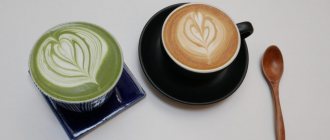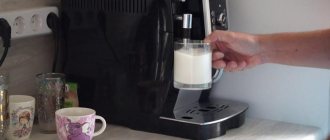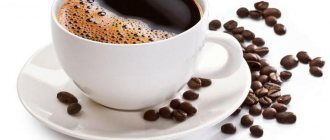The combination of coffee with milk has long been not limited to the classic recipe - velvety latte, airy cappuccino and delicate macchiato are very popular. Despite the variety of coffee drinks, there are still debates about the benefits and negative effects of the famous flavor tandem. Fans of natural grain products believe that any additives harm the quality, but the number of fans of coffee with milk is increasing every year.
History of creation
In Northern Europe, the name “café au lait” is common, since the unusual drink first appeared in France. The Austrians are not far behind in creating a legend, claiming that their country became the birthplace of the coffee and milkshake back in the 17th century.
Later, the amazing taste was appreciated in other European countries, America and Russia. It doesn’t matter who was the first to risk making coffee with milk in an attempt to improve the properties of a natural product, today the drink occupies a leading position in the list of favorite delicacies.
Diet menu with latte
For these purposes, you should drink a latte without sugar, syrups or cream. Milk is only skimmed or with a fat content of 2.5%.
This latte is included in the diet as a morning drink or as a snack, since the drink reduces the feeling of hunger and gives the body energy.
How to diet
The diet should contain only low-calorie foods: vegetables and fruits with low amounts of starch, fermented milk products, lean meat, fish and poultry.
Avoid fatty foods, confectionery, sugar, carbonated drinks, smoked sausages and fast food.
For this latte you need to take whole coffee beans and medium fat milk (2.5%). Since lattes from McDonald's or Starbucks contain a large amount of sweet ingredients, these lattes are not suitable for dieting. Latte should be drunk no more than three times a day. No syrup, ice cream or sugar. The taste can be improved with cinnamon or nutmeg.
In addition, you need to drink about 1.5 liters of still mineral water and green tea.
This diet lasts for at least 7 days. If tolerance is good, you can extend it up to two weeks.
To use HiKi, you must calculate your energy needs and energy expenditure during the day.
Determination of energy needs
Basal metabolic rate (BM) is the minimum (basic) level of energy expenditure necessary to maintain the body’s vital functions in conditions of physical and emotional rest.
Basal metabolic conditions: morning, lying down, awake, muscles relaxed, on an empty stomach, ambient temperature about 22˚C
Formula:
Main Exchange (BM)
Basic metabolic conditions are calculated using the Harris-Benedict formula and it is different for men and women:
Men
Basal metabolic rate = 66.47 + 13.75 x body weight (kg) + 5.0 x height (cm) - 6.74 x age (years)
Women
Basal metabolic rate = 655.1 + 9.6 x body weight (kg) + 1.85 x height (cm) - 4.68 x age (years)
Then you need to calculate your daily energy consumption:
SET = OO + 10% + Walking (kcal per day) + DET (hobbies and workouts total per week / 7).
- OO - you've already counted it.
- 10% is SDDP, as well as momentary and emotional energy expenditure. The specific-dynamic effect of food can have different energy consumption depending on the content of proteins, carbohydrates and fats in the food. The greatest energy consumption occurs during the digestion of proteins (up to 30-40%). For fats it is 10-14%, and for carbohydrates – 4-6%.
With a balanced intake of individual food components, an increase in basal metabolism is observed by an average of 10-15%.
- Walking - average energy expenditure for walking per day in kcal: Time (hours) x 3 kcal/kg/hour x BW (kg)
4.DET - additional energy expenditure: hobbies, training, professional activities. All specific energy expenditures for additional physical activity per week are added up and divided by 7, thus obtaining the average figure per day (kcal).
Below is a weekly menu with coffee without sugar. You will need to weigh your food, calculate energy expenditure and determine kilocalories. With the right diet and calculation, you can adjust your diet, even drink lattes or coffee with sweeteners. For the latter, you will have to sacrifice some components of your diet that day or increase energy expenditure, say, for sports training.
Weekly menu
The menu is the basis of the diet; you can diversify it by making calculations and changing the components of the diet.
Cooking methods
The French advise adding a little warmed milk to already brewed espresso so that it does not lose its individuality and basic qualities. Coffee brewed with milk has a milder taste.
There are many variations of popular recipes: you can add coffee to milk or vice versa, flavor the portion with aromatic spices or honey, serve hot or chilled. There are many types of coffee and milk combinations, among which everyone will choose their own.
| Mocha | A pleasant tandem of espresso, chocolate, whipped cream and milk. |
| Honey raf | The base of the mixture is liquid honey, to which is added espresso, seasoned with a good portion of frothed milk. |
| Cafe-o-le | The French recipe requires a minimum amount of espresso with a large volume of milk. |
| Brauner | The Austrian version of the French method of preparation - more milk and less espresso. |
| Breve | Classic espresso is filled with milk and cream mixture. |
| Flat white | A successful combination of strong espresso and frothed milk. |
| Latte macchiato | The cocktail is distinguished not only by its pleasant taste, but also by its beautiful presentation: a layer of milk, coffee, milk foam. |
| Macchiato | A laconic execution of the previous drink - espresso, the thinnest layer of milk foam. |
| Cappuccino | The perfect middle ground where milk neutralizes the caffeine. |
| Latte | Only ¼ cup is reserved for coffee, then milk and fluffy milk foam are added. |
Any milk is suitable for a regular brewed drink - in this case, you can give free rein to your imagination and experiment with flavors. Cappuccino and latte “make friends” only with fatty varieties, and in espresso prepared by drip brewing, it is better not to add milk, so as not to spoil the special flavor of the product.
Appearance
Cappuccino is served in a pre-heated white porcelain cup with a capacity of 150 to 180 ml. The drink should have a glossy white foam with a smooth, silky texture, without large bubbles, reminiscent of liquid cream.
In addition, the foam should be decorated with the characteristic “ring” of espresso. Apparently, its width and smooth outline depend on the barista’s ability and desire to provide aesthetic pleasure.
Benefits of the drink
It has been scientifically proven that drinking coffee with milk is healthier:
- Tandem contains antioxidants, minerals and vitamins, slows down the aging process, has a beneficial effect on the skin and maintains health at the cellular level.
- You can treat yourself to a cup of aromatic espresso with added milk even in the evening without worrying about the quality of your sleep.
- A successful combination prevents the development of tumor formations and prevents gastrointestinal diseases.
Nutritionists advise including the drink in your diet in moderation. Thanks to its mild diuretic effect and low calorie content, the health benefits of coffee with natural milk are obvious.
- This is interesting: Calorie content of coffee with milk with and without sugar
What determines the calorie content of a latte?
The calorie content of a latte differs depending on the amount and type of milk, fat content, as well as the additives, syrups, spices and decorations used.
Lattes with syrup or chocolate contain high levels of sugar and therefore have high nutritional value.
This is a cocktail, the energy value of which is determined by the ingredients. According to the classic latte recipe, 150 ml of 3.2% milk is used in 200 ml. The calorie content of such a latte without additives, without sugar, will be 95 kcal. If you add sugar at the rate of 2 teaspoons, you get 149 kcal in a 200 ml latte.
Possible harm and restrictions
The natural product contains caffeine, which in moderate quantities is even beneficial for the body, but an increased dosage can be harmful. Milk reduces the effects of caffeine, but regular and uncontrolled consumption of the drink is fraught with a serious response:
- If you are lactose intolerant, you may develop diarrhea and other gastrointestinal disorders.
- Caffeine flushes out many minerals from the body, including potassium, magnesium and sodium - milk only normalizes calcium levels.
- If you follow a diet, the drink will have to be excluded from the diet, otherwise the extra centimeters will remain on the waist.
- Milk will “give” coffee additional calories.
- The milk-coffee tandem is addictive . A cup a day is enough for later giving up the habit to become psychologically difficult and painful.
- Not suitable for morning awakening and increased blood pressure.
Drinking is contraindicated:
- during pregnancy and lactation;
- with urolithiasis;
- for diseases of the cardiovascular system.
Also strictly taboo is Alzheimer's disease, Parkinson's disease and other ailments associated with disruption of the nervous system and brain.
Coffee with milk is harmful to the human body due to the “astringent” properties of the components. Acid secretion has difficulty digesting the complex substance, which settles in the stomach for a long time, which over time provokes the development of a tumor. Doctors reassure that if you drink 1 cup a day, you don’t have to worry about the negative impact of the milk-coffee mixture on the gastrointestinal tract.
Calculation of calorie content of milk in latte
Example:
There are 180 milliliters of milk in a 240 ml glass.
If you take packaged 1.5% - 44/100*180 = 79.
For low-fat soybean – 28/100*180 = 50.
For homemade lattes, the calculations are so easy. At a coffee shop, you can ask what and how much they use, a serving of coffee, and make a quick calculation. In well-known chain establishments, the menu indicates the detailed composition of drinks. Common branded coffee chains display the calories in their lattes.
If the drink is classic and does not contain syrups or sweeteners, you need to focus only on milk. Add 2 kcal of espresso if you want accuracy.
Calories in latte with sugar
All people are conditionally divided into 3 categories based on their love for coffee: non-coffee drinkers; those who drink but are not keen on coffee; as well as drink lovers. Lattes are especially loved by women for their creamy taste and delicate foam. You need to calculate the total calories, depending on the sweetener used.
A teaspoon holds about 6 grams of sugar with 20 kcal.
Most syrups contain approximately 40 kcal per 10 ml, which is equal to two teaspoons or two pumps. A large cup requires 20 ml of syrup, respectively, contains 75-80 kcal of energy. A stick of sugar will add 20 kcal. Soluble powders and concentrates are higher in calories.
Brands produce lattes in the form of dry powder in bags. They can be sugar-free or with sugar, where dry milk extracts (concentrates) and flavorings are used. Some manufacturers add foaming ingredients. For example, Jacobs latte bags contain 70 kcal. A large latte with additives in coffee shops will add 250-280 kcal without sweeteners.











